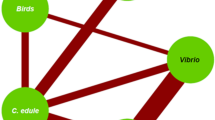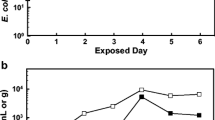Abstract
The presence of Vibrio parahaemolyticus in bivalve mollusc is an important cause of foodborne illnesses, and their levels are influenced by environmental changes, such as temperature and salinity. Clams are common species in estuaries and are used in environmental monitoring programmes. Present study compared the uptake and retention of nonpathogenic V. parahaemolyticus by two species of clam (Ruditapes decussatus and R. philippinarum), cohabitating in a closed system. Results showed no significant differences were found between both species of clams. Bacterial levels are following a similar trend with values between 3.48 and 3.70 log CFU/g for R. decussatus and between 3.15 and 3.49 log CFU/g for R. philippinarum. So, in the absence of water renewal, high and stable levels of V. parahaemolyticus were observed in cultured clams after exposure. Changes in physical parameters should be taken into account to design surveillance programmes in bivalves, and sampling should focus on species that have faster filtration rates at that water temperature since they potentially represent the worst-case scenario.

Similar content being viewed by others
References
Anonymous (2009) Guide for the control of molluscan shellfish. National Shellfish Sanitation Program. http://www.fda.gov. Accessed 23 Aug 2012
Bej AK, Patterson DP, Brasher CW, Vickery MC, Jones DD, Kaysner CA (1999) Detection of total and hemolysin-producing Vibrio parahaemolyticus in shellfish using multiplex PCR amplification of tl, tdh and trh. J Microbiol Methods 36:215–225
Cheng W, Hsiao IS, Chen JC (2004) Effect of nitrite on immune response of Taiwan abalone Haliotis diversicolor supertexta and its susceptibility to Vibrio parahaemolyticus. Dis Aquat Org 60:157–164
Cheng W, Hsiao IS, Hsu CH, Chen JC (2004) Change in water temperature on the immune response of Taiwan abalone Haliotis diversicolor supertexta and its susceptibility to Vibrio parahaemolyticus. Fish Shellfish Immunol 17:235–243
Cheng W, Juang FM, Chen JC (2004) The immune response of Taiwan abalone Haliotis diversicolor supertexta and its susceptibility to Vibrio parahaemolyticus at different salinity levels. Fish Shellfish Immunol 16:295–306
Croci L, Suffredini E, Cozzi L, Toti L (2002) Effects of depuration of molluscs experimentally contaminated with Escherichia coli, Vibrio cholerae 01 and Vibrio parahaemolyticus. J Appl Microbiol 92:460–465
Daniels NA, MacKinnon L, Bishop R, Altekruse S, Ray B, Hammond RM, Thompson S, Wilson S, Bean NH, Griffin PM, Slutsker L (2000) Vibrio parahaemolyticus infections in the United States, 1973–1998. J Infect Dis 181:1661–1666
de Abreu Correa A, Albarnaz JD, Moresco V, Poli CR, Teixeira AL, Oliveira Simoes CM, Monte Barardi CR (2007) Depuration dynamics of oysters (Crassostrea gigas) artificially contaminated by Salmonella enterica serovar Typhimurium. Mar Environ Res 63:479–489
DePaola A, Hopkins LH, Peeler JT, Wentz B, McPhearson RM (1990) Incidence of Vibrio parahaemolyticus in U.S. coastal waters and oysters. Appl Environ Microbiol 56:2299–2302
Drummond LC, Balboa S, Beaz R, Mulcahy MF, Barja JL, Culloty SC, Romalde JL (2007) The susceptibility of Irish-grown and Galician-grown Manila clams, Ruditapes philippinarum, to Vibrio tapetis and brown ring disease. J Invertebr Pathol 95:1–8
Epifanio CE, Ewart J (1977) Maximum ration of four diets for the oyster Crassostrea virginica Gmelin. Aquaculture 11:13–29
European Communities (1991) Council Directive of 15th of July 1991 laying down the health conditions for the production and placing on the market of live bivalve mollusks (91/492/EEC). Off J Eur Communities 268:1–14
Gutiérrez Gómez F (2002) Producción de larvas y semillas de moluscos. Una perspectiva industrial. http://www.mispeces.com/estudios/2002/moluscos-fgg/moluscos-fgg.asp. Accessed 11 Oct 2012
Lopez-Joven C, Ruiz-Zarzuela I, de Blas I, Furones MD, Roque A (2011) Persistence of sucrose fermenting and nonfermenting vibrios in tissues of Manila clam species, Ruditapes philippinarum, depurated in seawater at two different temperatures. Food Microbiol 28:951–956
Lopez-Joven C, de Blas I, Ruiz-Zarzuela I, Furones MD, Roque A (2011) Experimental uptake and retention of pathogenic and nonpathogenic Vibrio parahaemolyticus in two species of clams: Ruditapes decussatus and Ruditapes philippinarum. J Appl Microbiol 111:197–208
Lozano-Leon A, Torres J, Osorio CR, Martinez-Urtaza J (2003) Identification of tdh-positive Vibrio parahaemolyticus from an outbreak associated with raw oyster consumption in Spain. FEMS Microbiol Lett 226:281–284
Marino A, Lombardo L, Fiorentino C, Orlandella B, Monticelli L, Nostro A, Alonzo V (2005) Uptake of Escherichia coli, Vibrio cholerae non-O1 and Enterococcus durans by, and depuration of mussels (Mytilus galloprovincialis). Int J Food Microbiol 99:281–286
Martinez-Urtaza J, Simental L, Velasco D, DePaola A, Ishibashi M, Nakaguchi Y, Nishibuchi M, Carrera-Flores D, Rey-Alvarez C, Pousa A (2005) Pandemic Vibrio parahaemolyticus O3:K6, Europe. Emerg Infect Dis 11:1319–1320
McLaughlin JB, DePaola A, Bopp CA, Martinek KA, Napolilli NP, Allison CG, Murray SL, Thompson EC, Bird MM, Middaugh JP (2005) Outbreak of Vibrio parahaemolyticus gastroenteritis associated with Alaskan oysters. N Engl J Med 353:1463–1470
Mead PS, Slutsker L, Dietz V, McCaig LF, Bresee JS, Shapiro C, Griffin PM, Tauxe RV (1999) Food-related illness and death in the United States. Emerg Infect Dis 5:607–625
Miles DW, Ross T, Olley J, McMeekin TA (1997) Development and evaluation of a predictive model for the effect of temperature and water activity on the growth rate of Vibrio parahaemolyticus. Int J Food Microbiol 38:133–142
Molero X, Bartolome RM, Vinuesa T, Guarner L, Accarino A, Casellas F, Garcia R (1989) Acute gastroenteritis due to Vibrio parahaemolyticus in Spain. Presentation of 8 cases. Med Clin (Barc) 92:1–4
Nordstrom JL, Vickery MC, Blackstone GM, Murray SL, DePaola A (2007) Development of a multiplex real-time PCR assay with an internal amplification control for the detection of total and pathogenic Vibrio parahaemolyticus bacteria in oysters. Appl Environ Microbiol 73:5840–5847
Paillard C, Allam B, Oubella R (2004) Effect of temperature on defense parameters in manila clam Ruditapes philippinarum challenged with Vibrio tapetis. Dis Aquat Org 59:249–262
Pérez Camacho A, Delgado M, Albentosa M (2002) Influencia del tamaño y la concentración de alimento sobre las tasas de aclaramiento e ingestión de la almeja Ruditapes decussatus (Linnaeus, 1758). Bol Inst Esp Oceanogr 18:315–320
Reid HI, Soudant P, Lambert C, Paillard C, Birkbeck TH (2003) Salinity effects on immune parameters of Ruditapes philippinarum challenged with Vibrio tapetis. Dis Aquat Org 56:249–258
Roque A, Lopez-Joven C, Lacuesta B, Elandaloussi L, Wagley S, Furones MD, Ruiz-Zarzuela I, de Blas I, Rangdale R, Gomez-Gil B (2009) Detection and identification of tdh- and trh-positive Vibrio parahaemolyticus strains from four species of cultured bivalve molluscs on the Spanish Mediterranean Coast. Appl Environ Microbiol 75:7574–7577
Schulte EH (1975) Influence of algal concentration and temperature on the filtration rate of Mytilus edulis. Mar Biol 30:331–341
Sobral P, Widdows J (1997) Effects of elevated temperatures on the scope for growth and resistance to air exposure of the clam Ruditapes decussatus (L.) from southern Portugal. Sci Mar 61:163–171
Walne PR (1972) The influence of current speed, body size, and water temperature on the filtration rate of five species of bivalves. J Mar Biol Assoc UK 52:345–374
Winter JE (1978) A review on the knowledge of suspension-feeding in lamellibranchiate bivalves, with special reference to artificial aquaculture systems. Aquaculture 13:1–33
Yoon KS, Min KJ, Jung YJ, Kwon KY, Lee JK, Oh SW (2008) A model of the effect of temperature on the growth of pathogenic and nonpathogenic Vibrio parahaemolyticus isolated from oysters in Korea. Food Microbiol 25:635–641
Acknowledgments
The present study was financed by INIA project Nos. RTA 2005 00079 00 00 and RTA 2007 00063 00 00 with Feder funds awarded to AR. CLJ has a doctoral scholarship provided by INIA.
Author information
Authors and Affiliations
Corresponding author
Rights and permissions
About this article
Cite this article
Lopez-Joven, C., Roque, A., Pérez-Larruscain, J. et al. Uptake and Retention of Vibrio parahaemolyticus in a Cohabitating Population of Ruditapes decussatus and Ruditapes philippinarum Under Experimental Conditions. Curr Microbiol 67, 36–40 (2013). https://doi.org/10.1007/s00284-013-0331-8
Received:
Accepted:
Published:
Issue Date:
DOI: https://doi.org/10.1007/s00284-013-0331-8




